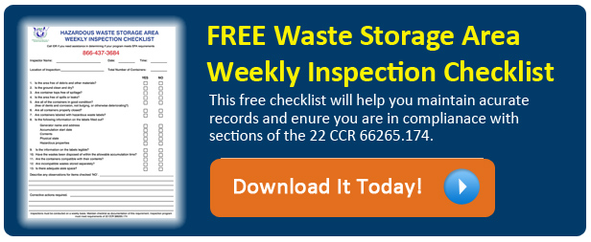How To Ace a Hazardous Waste Container Inspection
So, you were never that great at taking tests in school, but can your company pass it's hazardous waste storage containers inspections?
The proper handling of hazardous waste is critical to the protection of the health and safety of the public, your company, and most importantly to you. If any employee, who is responsible for the weekly inspection, fails to perform their duties responsibly, everyone is at potential risk of serious health problems.
It's better to be able to prevent toxic spills before they happen, rather than working to clean up a preventable mess and health risk.
To help make the process of a hazardous waste container inspection easier, we have created a free downloadable hazardous waste container inspection checklist for you.
State and federally mandated weekly inspections will ensure that your company follows EPA regulations and the EPA has put together a detailed handbook that includes management and labeling procedures you should have in place.
The EPA sums up their Best Practices Handbook with these points:
- The first, and most important task is for the generator to determine the composition and characteristics of the hazardous waste.
- The next step is to use that knowledge regarding the characteristics of the waste, to choose a container which will be compatible with the waste.
- After the waste is containerized, it should be marked or labeled appropriately, and moved into a container storage area.
- Once the container is transferred to a container storage area, it must be inspected weekly and kept in good condition until it leaves the site.
Here are the minimum standards that your checklist should include:
1. Leaks or staining from containers:
Visual inspections should be thorough. You've seen how long it takes pilots to check airplanes for damage prior to flight. You should just as thorough when inspecting your containers.
2. Container condition, including dents, bulging, and/or corrosion:
Most of us don't buy groceries where the canned goods are bulging or dented, doesn't that make you think something is wrong with them? Corrosion on the can certainly would, so apply the same standard here.
3. Labeling -- start date, the words “Hazardous Waste” and other information:
You must know what's in each container, how long it's been there and what dangers it could lead to, and how to mitigate any issues.
4. Management practices -- such as aisle space, drum stacking:
Are combustibles in a proper storage area? Does your facility have a "blast wall" separating the combustibles from other wastes? Can your employees do a complete walk around the containers?
In the area of health, safety and proper handling, taking both risk and shortcuts is improper handling.
Here are some TIPS for conducting proper weekly inspections:
- Follow the inspection checklist -- make detailed notes if you find something wrong.
- Be thorough. Check the tops of drums to look for waste residue or corrosion.
- Walk all the way around containers -- check entire storage area.
- Check containment area for stains.
- Note anything unusual in containment area -- even if it might not be a problem.
- If problems are found, get the problem taken care of immediately.
- Keep a logbook of the facility’s inspection checklist.
Check with the EPA and your local hazardous waste disposal company for complete and up to date, rules and regulations. As we know, lawmakers love to make new laws, and being prepared for the next test is always a best practice.


Comment